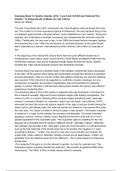Summary Book 14. Smelik, Anneke. 2018. “Lara Croft, Kill Bill and Feminist Film
Studies.” In Doing Gender in Media, Art and Culture.
Elena van Hattum
The first Tomb Raider film (2001) introduces Lara Croft (Angelina Jolie) as the girl that kicks
ass. The conflict is of minor importance (typical of Hollywood), the only important thing is that
it is between good and bad, and good will win. Lara is depicted as a true ‘warrior’, strong and
beautiful: the combination of strength and beauty has characterized film heroines since the
1990s. Traditionally, the hero was a man. In the 1980s the female heroine emerged, fighting
and swearing like a man. After this she became as erotically attractive as the early female
stars: eroticized as a woman, masculinized as action heroine. Lara Croft is an example of
this.
In the beginning of the twenty-first century there were two quite different tendencies in
contemporary visual culture, which Lara Croft from Tomb Raider and Beatrix Kiddo from the
Kill Bill f ilms embody: Lara can be analysed through classic feminist film theory, Beatrix
exceeds this. New cultural practices acquire new theoretical concepts.
Feminist theory has been an important factor in film studies. Feminist film theory developed
in the early 1970s (second wave) along with structuralism through the influence of semiotics
and psychoanalysis. Here it is not the content that matters (meaning), but how this meaning
was acquired. A film should not be regarded as a reflection of given meanings, but as a
construction o f meaning: the process of signification was most important for analysing
gender in cinema. Recently a shift has been taking place towards the sensory and affective
experience of watching films.
The absorbing effect of film in film studies is explained with psychoanalysis. Fascination for
film is linked to sexuality: Sigmund Freud’s eroticism begins with looking (scopophilia). The
viewer of a film is a voyeur. Watching films has been always something erotic, especially
cinema, in contrast to theater (no voyeurism: actors can look back). Laura Mulvey (1975)
advanced the idea that active and passive aspects of the urge to look are divided among the
sexes: just as John Berger said, men look and women are looked at. The camera films what
the man sees. The viewer is invited or forced to adopt a male position. The female character
is looked at in 3 ways: by the camera, the character and spectator. The whole cinematic
apparatus (camera, framing, editing, music) objectify the woman’s body and turn it into a
passive spectacle for the voyeuristic gaze. This voyeuristic gaze is unsettling for the man
because he is reminded that the woman is different (Freud: ‘castrated’, inferior). While film
has changed, the principle of the ‘male gaze’ is still very much the same. In cultural products
such as film the male fear of the female body has to be averted, this happens in 2 ways
according to Mulvey: 1. sadism: the woman’s body has to be controlled and inserted into
social order. (often violent) 2. fetishism: female is turned into an ideal beauty, a fetish, her
perfection turns the attention away from her difference. This is what happens to Hollywood
female stars.
-This analysis of the gaze is not only relevant to gender, but also for example race. The
Hollywood system is geared towards the white star. This consists of gendered AND racial
stereotyping. ‘The Other’ in films is nearly always linked to sexuality.






